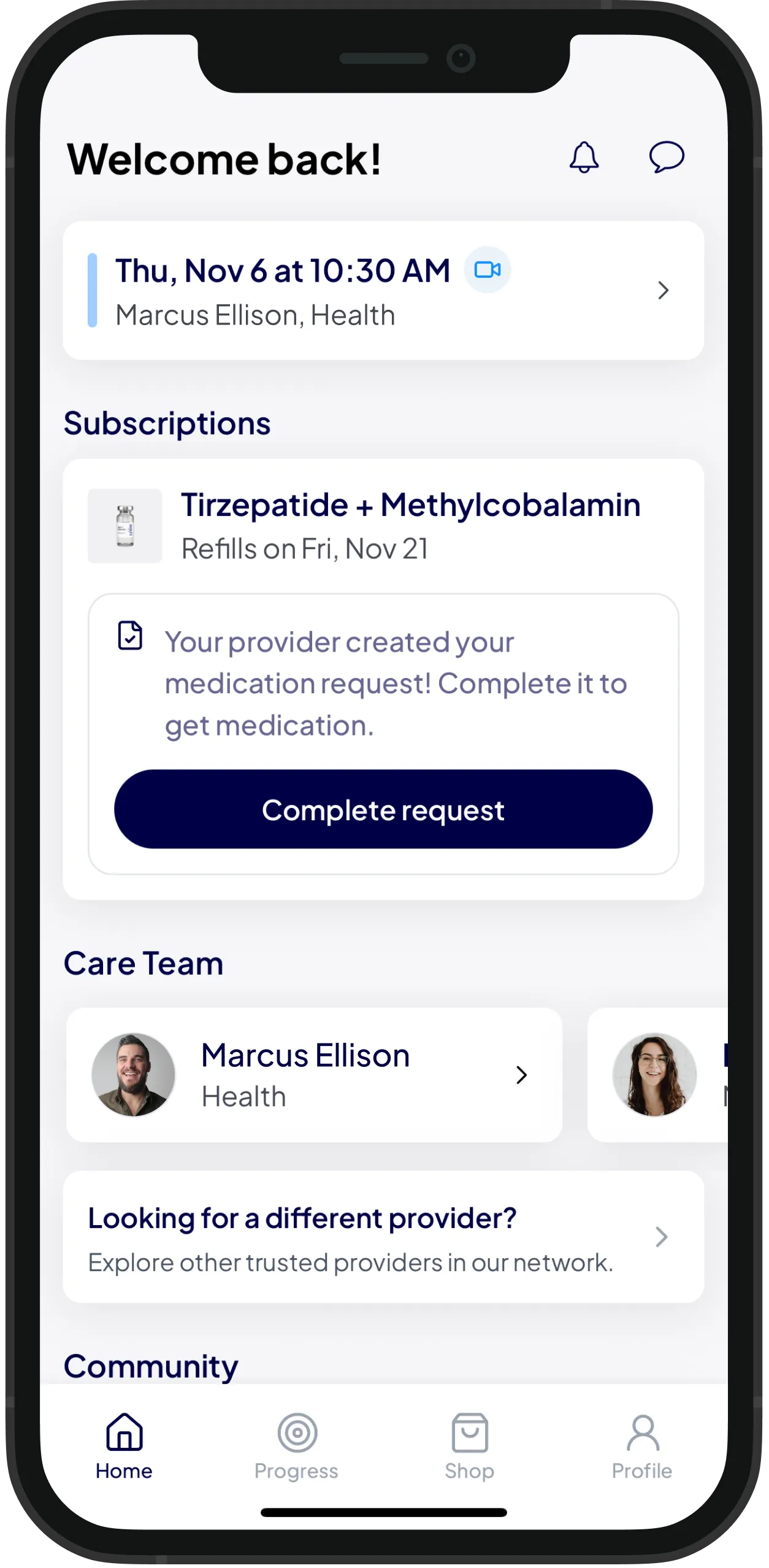Ready to transform your health?
Unlock access to expert guidance and a weight care plan crafted just for you.
Ready to transform your health?
Unlock access to expert guidance and a weight care plan crafted just for you.
Similar Articles
Similar Articles


Which Additive is Best for You? GLP-1 Additives Explained: B12, L-Carnitine, and More
Which Additive is Best for You? GLP-1 Additives Explained: B12, L-Carnitine, and More


Mochi NAD+: Understanding How This Essential Molecule Supports Energy, Cellular Health, and Longevity
Mochi NAD+: Understanding How This Essential Molecule Supports Energy, Cellular Health, and Longevity


Wegovy® vs Ozempic® for Weight Loss
Wegovy® vs Ozempic® for Weight Loss
Does Wegovy® Cause Nausea? Navigating Side Effects and Treatments
Does Wegovy® Cause Nausea? Navigating Side Effects and Treatments
Does Wegovy® Cause Nausea? Navigating Side Effects and Treatments
Learn about Wegovy® and its side effects, including whether it can cause nausea. Get tips on managing this common side effect for better treatment adherence.
Learn about Wegovy® and its side effects, including whether it can cause nausea. Get tips on managing this common side effect for better treatment adherence.
Learn about Wegovy® and its side effects, including whether it can cause nausea. Get tips on managing this common side effect for better treatment adherence.



Table of Contents
Table of Contents
Table of Contents
Why Does Wegovy® Induce Nausea?
How to Alleviate Nausea When Taking Wegovy
Precautions to Minimize Nausea on Wegovy
Evaluating Nausea Among Various Weight Loss Medications
Key Takeaways For Managing Nausea on Wegovy
Why Does Wegovy® Induce Nausea?
How to Alleviate Nausea When Taking Wegovy
Precautions to Minimize Nausea on Wegovy
Evaluating Nausea Among Various Weight Loss Medications
Key Takeaways For Managing Nausea on Wegovy
Why Does Wegovy® Induce Nausea?
How to Alleviate Nausea When Taking Wegovy
Precautions to Minimize Nausea on Wegovy
Evaluating Nausea Among Various Weight Loss Medications
Key Takeaways For Managing Nausea on Wegovy
Wegovy, a newer player in the field of weight loss medications, has received much attention for its effectiveness. However, potential users are understandably concerned about side effects, particularly nausea. Understanding why Wegovy® may cause nausea, how to alleviate it, and how it compares to other medications is crucial for those considering this treatment option.
Wegovy® activates GLP-1 receptors in the body, setting off intricate pathways that contribute to weight loss by suppressing appetite, promoting feelings of fullness, and regulating blood sugar levels. Medications like Wegovy® target these receptors, but there's still ongoing research to understand how they can sometimes lead to nausea. Here's what we've discovered so far about the connection between Wegovy® and nausea.
Why Does Wegovy® Induce Nausea?
Wegovy® works by mimicking a hormone that targets areas in the brain involved in appetite regulation, leading to a reduced urge to eat. This alteration in normal digestive and appetite signals can cause side effects, including nausea. Here are some key points to understand:
Wegovy® suppresses appetite, which can unsettle the stomach and lead to a feeling of nausea (3) When you're hungry, your body sends signals from your stomach to your brain, urging you to eat. Once you've eaten, there's a complex system at play that tells your brain when you've had enough, signaling fullness or satiety. Wegovy® works by slowing down this process in your stomach and intestines, creating a feeling of being satisfied. However, humans can still override this system. Overeating can lead to discomfort, nausea, and vomiting. Listening to your body's signals is important and can help mitigate these side effects.
Wegovy® also affects gastrointestinal motility, disrupting normal stomach and intestinal movements contributing to nausea (3). In studies with mice, researchers have discovered that GLP-1 agonists can interact with receptors located in the area postrema, often referred to as the "vomiting center" of the brain. While it's important to note that mice and humans have differences, this finding suggests that humans might have a comparable pathway. This pathway could potentially contribute to the experience of nausea in individuals taking a GLP-1 agonist medication like Wegovy® (1,2)
How to Alleviate Nausea When Taking Wegovy
For those experiencing nausea while on Wegovy®, several strategies can help manage and potentially reduce this side effect:
Eat Small, Frequent Meals: Avoiding large meals can help prevent overwhelming the stomach, reducing the risk of nausea.
Stay Hydrated: Drinking fluids, especially water, can help ease nausea.
Aromatherapy: Smelling peppermint or ginger essential oils has been shown to alleviate nausea and vomiting. Regular inhalation of these oils can offer relief from nausea (6)
Smelling Alcohol pads: Inhaling the scent of alcohol pads has been found to quickly relieve nausea and vomiting, though the exact mechanism remains unclear. Alcohol scent seems to signal the brain to alleviate these symptoms, making it a fast and effective remedy in emergencies (4)
Breathing exercises: Controlled breathing can relieve nausea by promoting relaxation, reducing anxiety, and regulating the autonomic nervous system. This technique triggers the "rest and digest" response, calming both body and mind during nausea (5).
Consult Your Doctor: If nausea persists, modifying the dosage under medical supervision may be beneficial. Your doctor could also consider prescribing anti-nausea medications such as Zofran.
Precautions to Minimize Nausea on Wegovy
Taking proactive steps can help minimize the occurrence of nausea while using Wegovy:
Gradual Dosage Increase: Starting with a lower dose and gradually increasing it allows your body to adjust, potentially reducing nausea.
Timing of Dosage: Some find that taking Wegovy® at a certain time of day, such as with a meal or before bed, can lessen nausea.
Avoid Trigger Foods: Identifying and avoiding foods that exacerbate nausea can also provide relief.
Evaluating Nausea Among Various Weight Loss Medications
When comparing Wegovy® to other weight loss medications like tirzepatide and liraglutide, it's obvious they share similar mechanisms of action, resulting in comparable side effects, including nausea. For Wegovy®, nausea rates range from 16% to 44%, depending on the dosage. Here's a quick breakdown:
Tirzepatide: This newer medication, showing promise in weight management, also impacts appetite and digestion, with nausea reported in approximately 12% to 29% of cases.
Liraglutide: Like Wegovy®, liraglutide affects appetite centers in the brain. Nausea is one of the most commonly reported side effects — nausea rates for liraglutide range from 39% to 42%.
Explore other medications here: https://joinmochi.com/medications
Key Takeaways For Managing Nausea on Wegovy
Nausea is a common side effect of weight loss medications like Wegovy®, often due to its impact on appetite, gastrointestinal motility, and brain pathways.
Approaches to alleviating nausea include eating smaller meals, staying hydrated, and possibly adjusting the medication under a doctor’s guidance.
Wegovy’s effect on nausea is comparable to that of other medications, such as tirzepatide and liraglutide, with the potential for individual variance in response.
Navigating side effects like nausea while using Wegovy® requires a balanced approach of understanding, mitigation strategies, and consulting healthcare providers to find the best way forward for weight loss goals.
If you're seeking personalized weight loss guidance, consider joining Mochi Health. Our team of experts is here to provide you with the support and customized care you need to achieve your health goals. Start your journey to a healthier you with Mochi Health today by filling out this quick eligibility form.
Fulton, S., Horn, C. C., & Zhang, C. (2024). Characterizing a new tool to manipulate area postrema GLP1R+ neurons across species. Physiology & Behavior, 276, 114474–114474. https://doi.org/10.1016/j.physbeh.2024.114474
Kawatani, M., Yamada, Y., & Kawatani, M. (2018). Glucagon-like peptide-1 (GLP-1) action in the mouse area postrema neurons. Peptides (New York, N.Y. : 1980), 107, 68–74. https://doi.org/10.1016/j.peptides.2018.07.010
Hayes, M. R., Borner, T., & De Jonghe, B. C. (2021). The Role of GIP in the Regulation of GLP-1 Satiety and Nausea. Diabetes (New York, N.Y.), 70(9), 1956–1961. https://doi.org/10.2337/DBI21-0004
Veldhuis, P., Melse, M., & Mullaart, N. (2021). Implementation of isopropyl alcohol (IPA) inhalation as the first-line treatment for nausea in the emergency department: practical advantages and influence on the quality of care. International Journal of Emergency Medicine, 14(1), 15–15. https://doi.org/10.1186/s12245-021-00334-z
Cronin, S. N., Odom-Forren, J., Roberts, H., Thomas, M., Williams, S., & Wright, M. I. (2015). Effects of Controlled Breathing, With or Without Aromatherapy, in the Treatment of Postoperative Nausea. Journal of Perianesthesia Nursing, 30(5), 389–397. https://doi.org/10.1016/j.jopan.2015.03.010
Lua, P. L., & Zakaria, N. S. (2012). A Brief Review of Current Scientific Evidence Involving Aromatherapy Use for Nausea and Vomiting. The Journal of Alternative and Complementary Medicine (New York, N.Y.), 18(6), 534–540. https://doi.org/10.1089/acm.2010.0862
Wegovy, a newer player in the field of weight loss medications, has received much attention for its effectiveness. However, potential users are understandably concerned about side effects, particularly nausea. Understanding why Wegovy® may cause nausea, how to alleviate it, and how it compares to other medications is crucial for those considering this treatment option.
Wegovy® activates GLP-1 receptors in the body, setting off intricate pathways that contribute to weight loss by suppressing appetite, promoting feelings of fullness, and regulating blood sugar levels. Medications like Wegovy® target these receptors, but there's still ongoing research to understand how they can sometimes lead to nausea. Here's what we've discovered so far about the connection between Wegovy® and nausea.
Why Does Wegovy® Induce Nausea?
Wegovy® works by mimicking a hormone that targets areas in the brain involved in appetite regulation, leading to a reduced urge to eat. This alteration in normal digestive and appetite signals can cause side effects, including nausea. Here are some key points to understand:
Wegovy® suppresses appetite, which can unsettle the stomach and lead to a feeling of nausea (3) When you're hungry, your body sends signals from your stomach to your brain, urging you to eat. Once you've eaten, there's a complex system at play that tells your brain when you've had enough, signaling fullness or satiety. Wegovy® works by slowing down this process in your stomach and intestines, creating a feeling of being satisfied. However, humans can still override this system. Overeating can lead to discomfort, nausea, and vomiting. Listening to your body's signals is important and can help mitigate these side effects.
Wegovy® also affects gastrointestinal motility, disrupting normal stomach and intestinal movements contributing to nausea (3). In studies with mice, researchers have discovered that GLP-1 agonists can interact with receptors located in the area postrema, often referred to as the "vomiting center" of the brain. While it's important to note that mice and humans have differences, this finding suggests that humans might have a comparable pathway. This pathway could potentially contribute to the experience of nausea in individuals taking a GLP-1 agonist medication like Wegovy® (1,2)
How to Alleviate Nausea When Taking Wegovy
For those experiencing nausea while on Wegovy®, several strategies can help manage and potentially reduce this side effect:
Eat Small, Frequent Meals: Avoiding large meals can help prevent overwhelming the stomach, reducing the risk of nausea.
Stay Hydrated: Drinking fluids, especially water, can help ease nausea.
Aromatherapy: Smelling peppermint or ginger essential oils has been shown to alleviate nausea and vomiting. Regular inhalation of these oils can offer relief from nausea (6)
Smelling Alcohol pads: Inhaling the scent of alcohol pads has been found to quickly relieve nausea and vomiting, though the exact mechanism remains unclear. Alcohol scent seems to signal the brain to alleviate these symptoms, making it a fast and effective remedy in emergencies (4)
Breathing exercises: Controlled breathing can relieve nausea by promoting relaxation, reducing anxiety, and regulating the autonomic nervous system. This technique triggers the "rest and digest" response, calming both body and mind during nausea (5).
Consult Your Doctor: If nausea persists, modifying the dosage under medical supervision may be beneficial. Your doctor could also consider prescribing anti-nausea medications such as Zofran.
Precautions to Minimize Nausea on Wegovy
Taking proactive steps can help minimize the occurrence of nausea while using Wegovy:
Gradual Dosage Increase: Starting with a lower dose and gradually increasing it allows your body to adjust, potentially reducing nausea.
Timing of Dosage: Some find that taking Wegovy® at a certain time of day, such as with a meal or before bed, can lessen nausea.
Avoid Trigger Foods: Identifying and avoiding foods that exacerbate nausea can also provide relief.
Evaluating Nausea Among Various Weight Loss Medications
When comparing Wegovy® to other weight loss medications like tirzepatide and liraglutide, it's obvious they share similar mechanisms of action, resulting in comparable side effects, including nausea. For Wegovy®, nausea rates range from 16% to 44%, depending on the dosage. Here's a quick breakdown:
Tirzepatide: This newer medication, showing promise in weight management, also impacts appetite and digestion, with nausea reported in approximately 12% to 29% of cases.
Liraglutide: Like Wegovy®, liraglutide affects appetite centers in the brain. Nausea is one of the most commonly reported side effects — nausea rates for liraglutide range from 39% to 42%.
Explore other medications here: https://joinmochi.com/medications
Key Takeaways For Managing Nausea on Wegovy
Nausea is a common side effect of weight loss medications like Wegovy®, often due to its impact on appetite, gastrointestinal motility, and brain pathways.
Approaches to alleviating nausea include eating smaller meals, staying hydrated, and possibly adjusting the medication under a doctor’s guidance.
Wegovy’s effect on nausea is comparable to that of other medications, such as tirzepatide and liraglutide, with the potential for individual variance in response.
Navigating side effects like nausea while using Wegovy® requires a balanced approach of understanding, mitigation strategies, and consulting healthcare providers to find the best way forward for weight loss goals.
If you're seeking personalized weight loss guidance, consider joining Mochi Health. Our team of experts is here to provide you with the support and customized care you need to achieve your health goals. Start your journey to a healthier you with Mochi Health today by filling out this quick eligibility form.
Fulton, S., Horn, C. C., & Zhang, C. (2024). Characterizing a new tool to manipulate area postrema GLP1R+ neurons across species. Physiology & Behavior, 276, 114474–114474. https://doi.org/10.1016/j.physbeh.2024.114474
Kawatani, M., Yamada, Y., & Kawatani, M. (2018). Glucagon-like peptide-1 (GLP-1) action in the mouse area postrema neurons. Peptides (New York, N.Y. : 1980), 107, 68–74. https://doi.org/10.1016/j.peptides.2018.07.010
Hayes, M. R., Borner, T., & De Jonghe, B. C. (2021). The Role of GIP in the Regulation of GLP-1 Satiety and Nausea. Diabetes (New York, N.Y.), 70(9), 1956–1961. https://doi.org/10.2337/DBI21-0004
Veldhuis, P., Melse, M., & Mullaart, N. (2021). Implementation of isopropyl alcohol (IPA) inhalation as the first-line treatment for nausea in the emergency department: practical advantages and influence on the quality of care. International Journal of Emergency Medicine, 14(1), 15–15. https://doi.org/10.1186/s12245-021-00334-z
Cronin, S. N., Odom-Forren, J., Roberts, H., Thomas, M., Williams, S., & Wright, M. I. (2015). Effects of Controlled Breathing, With or Without Aromatherapy, in the Treatment of Postoperative Nausea. Journal of Perianesthesia Nursing, 30(5), 389–397. https://doi.org/10.1016/j.jopan.2015.03.010
Lua, P. L., & Zakaria, N. S. (2012). A Brief Review of Current Scientific Evidence Involving Aromatherapy Use for Nausea and Vomiting. The Journal of Alternative and Complementary Medicine (New York, N.Y.), 18(6), 534–540. https://doi.org/10.1089/acm.2010.0862
Wegovy, a newer player in the field of weight loss medications, has received much attention for its effectiveness. However, potential users are understandably concerned about side effects, particularly nausea. Understanding why Wegovy® may cause nausea, how to alleviate it, and how it compares to other medications is crucial for those considering this treatment option.
Wegovy® activates GLP-1 receptors in the body, setting off intricate pathways that contribute to weight loss by suppressing appetite, promoting feelings of fullness, and regulating blood sugar levels. Medications like Wegovy® target these receptors, but there's still ongoing research to understand how they can sometimes lead to nausea. Here's what we've discovered so far about the connection between Wegovy® and nausea.
Why Does Wegovy® Induce Nausea?
Wegovy® works by mimicking a hormone that targets areas in the brain involved in appetite regulation, leading to a reduced urge to eat. This alteration in normal digestive and appetite signals can cause side effects, including nausea. Here are some key points to understand:
Wegovy® suppresses appetite, which can unsettle the stomach and lead to a feeling of nausea (3) When you're hungry, your body sends signals from your stomach to your brain, urging you to eat. Once you've eaten, there's a complex system at play that tells your brain when you've had enough, signaling fullness or satiety. Wegovy® works by slowing down this process in your stomach and intestines, creating a feeling of being satisfied. However, humans can still override this system. Overeating can lead to discomfort, nausea, and vomiting. Listening to your body's signals is important and can help mitigate these side effects.
Wegovy® also affects gastrointestinal motility, disrupting normal stomach and intestinal movements contributing to nausea (3). In studies with mice, researchers have discovered that GLP-1 agonists can interact with receptors located in the area postrema, often referred to as the "vomiting center" of the brain. While it's important to note that mice and humans have differences, this finding suggests that humans might have a comparable pathway. This pathway could potentially contribute to the experience of nausea in individuals taking a GLP-1 agonist medication like Wegovy® (1,2)
How to Alleviate Nausea When Taking Wegovy
For those experiencing nausea while on Wegovy®, several strategies can help manage and potentially reduce this side effect:
Eat Small, Frequent Meals: Avoiding large meals can help prevent overwhelming the stomach, reducing the risk of nausea.
Stay Hydrated: Drinking fluids, especially water, can help ease nausea.
Aromatherapy: Smelling peppermint or ginger essential oils has been shown to alleviate nausea and vomiting. Regular inhalation of these oils can offer relief from nausea (6)
Smelling Alcohol pads: Inhaling the scent of alcohol pads has been found to quickly relieve nausea and vomiting, though the exact mechanism remains unclear. Alcohol scent seems to signal the brain to alleviate these symptoms, making it a fast and effective remedy in emergencies (4)
Breathing exercises: Controlled breathing can relieve nausea by promoting relaxation, reducing anxiety, and regulating the autonomic nervous system. This technique triggers the "rest and digest" response, calming both body and mind during nausea (5).
Consult Your Doctor: If nausea persists, modifying the dosage under medical supervision may be beneficial. Your doctor could also consider prescribing anti-nausea medications such as Zofran.
Precautions to Minimize Nausea on Wegovy
Taking proactive steps can help minimize the occurrence of nausea while using Wegovy:
Gradual Dosage Increase: Starting with a lower dose and gradually increasing it allows your body to adjust, potentially reducing nausea.
Timing of Dosage: Some find that taking Wegovy® at a certain time of day, such as with a meal or before bed, can lessen nausea.
Avoid Trigger Foods: Identifying and avoiding foods that exacerbate nausea can also provide relief.
Evaluating Nausea Among Various Weight Loss Medications
When comparing Wegovy® to other weight loss medications like tirzepatide and liraglutide, it's obvious they share similar mechanisms of action, resulting in comparable side effects, including nausea. For Wegovy®, nausea rates range from 16% to 44%, depending on the dosage. Here's a quick breakdown:
Tirzepatide: This newer medication, showing promise in weight management, also impacts appetite and digestion, with nausea reported in approximately 12% to 29% of cases.
Liraglutide: Like Wegovy®, liraglutide affects appetite centers in the brain. Nausea is one of the most commonly reported side effects — nausea rates for liraglutide range from 39% to 42%.
Explore other medications here: https://joinmochi.com/medications
Key Takeaways For Managing Nausea on Wegovy
Nausea is a common side effect of weight loss medications like Wegovy®, often due to its impact on appetite, gastrointestinal motility, and brain pathways.
Approaches to alleviating nausea include eating smaller meals, staying hydrated, and possibly adjusting the medication under a doctor’s guidance.
Wegovy’s effect on nausea is comparable to that of other medications, such as tirzepatide and liraglutide, with the potential for individual variance in response.
Navigating side effects like nausea while using Wegovy® requires a balanced approach of understanding, mitigation strategies, and consulting healthcare providers to find the best way forward for weight loss goals.
If you're seeking personalized weight loss guidance, consider joining Mochi Health. Our team of experts is here to provide you with the support and customized care you need to achieve your health goals. Start your journey to a healthier you with Mochi Health today by filling out this quick eligibility form.
Fulton, S., Horn, C. C., & Zhang, C. (2024). Characterizing a new tool to manipulate area postrema GLP1R+ neurons across species. Physiology & Behavior, 276, 114474–114474. https://doi.org/10.1016/j.physbeh.2024.114474
Kawatani, M., Yamada, Y., & Kawatani, M. (2018). Glucagon-like peptide-1 (GLP-1) action in the mouse area postrema neurons. Peptides (New York, N.Y. : 1980), 107, 68–74. https://doi.org/10.1016/j.peptides.2018.07.010
Hayes, M. R., Borner, T., & De Jonghe, B. C. (2021). The Role of GIP in the Regulation of GLP-1 Satiety and Nausea. Diabetes (New York, N.Y.), 70(9), 1956–1961. https://doi.org/10.2337/DBI21-0004
Veldhuis, P., Melse, M., & Mullaart, N. (2021). Implementation of isopropyl alcohol (IPA) inhalation as the first-line treatment for nausea in the emergency department: practical advantages and influence on the quality of care. International Journal of Emergency Medicine, 14(1), 15–15. https://doi.org/10.1186/s12245-021-00334-z
Cronin, S. N., Odom-Forren, J., Roberts, H., Thomas, M., Williams, S., & Wright, M. I. (2015). Effects of Controlled Breathing, With or Without Aromatherapy, in the Treatment of Postoperative Nausea. Journal of Perianesthesia Nursing, 30(5), 389–397. https://doi.org/10.1016/j.jopan.2015.03.010
Lua, P. L., & Zakaria, N. S. (2012). A Brief Review of Current Scientific Evidence Involving Aromatherapy Use for Nausea and Vomiting. The Journal of Alternative and Complementary Medicine (New York, N.Y.), 18(6), 534–540. https://doi.org/10.1089/acm.2010.0862
Read next

GLP 1s and Cardiometabolic Health: How These Medications Support the Heart and Long Term Wellness
READ NOW

Mochi NAD+: Understanding How This Essential Molecule Supports Energy, Cellular Health, and Longevity
READ NOW
Read next

GLP 1s and Cardiometabolic Health: How These Medications Support the Heart and Long Term Wellness
READ NOW

Mochi NAD+: Understanding How This Essential Molecule Supports Energy, Cellular Health, and Longevity
READ NOW
Read next

GLP 1s and Cardiometabolic Health: How These Medications Support the Heart and Long Term Wellness
READ NOW

Mochi NAD+: Understanding How This Essential Molecule Supports Energy, Cellular Health, and Longevity
READ NOW
Ready to transform your health?
Unlock access to expert guidance and a weight care plan crafted just for you.

© 2025 Mochi Health
All professional medical services are provided by licensed physicians and clinicians affiliated with independently owned and operated professional practices. Mochi Health Corp. provides administrative and technology services to affiliated medical practices it supports, and does not provide any professional medical services itself.


© 2025 Mochi Health
All professional medical services are provided by licensed physicians and clinicians affiliated with independently owned and operated professional practices. Mochi Health Corp. provides administrative and technology services to affiliated medical practices it supports, and does not provide any professional medical services itself.


© 2025 Mochi Health
All professional medical services are provided by licensed physicians and clinicians affiliated with independently owned and operated professional practices. Mochi Health Corp. provides administrative and technology services to affiliated medical practices it supports, and does not provide any professional medical services itself.













